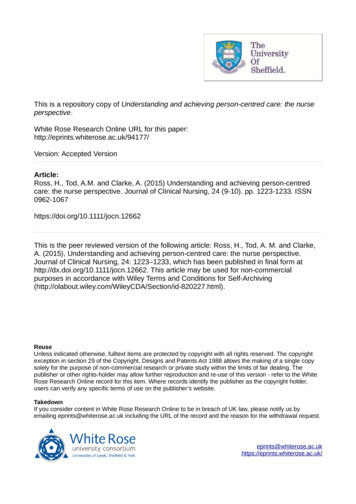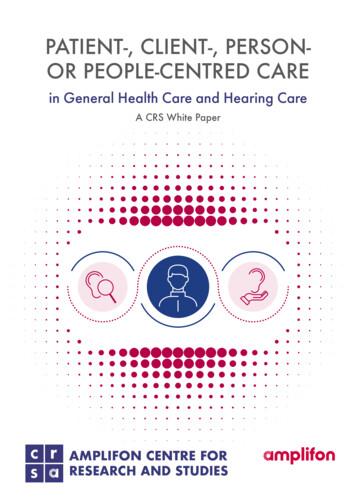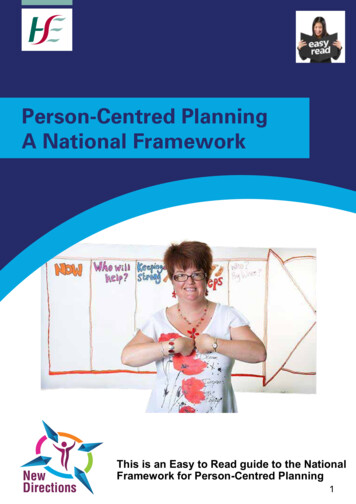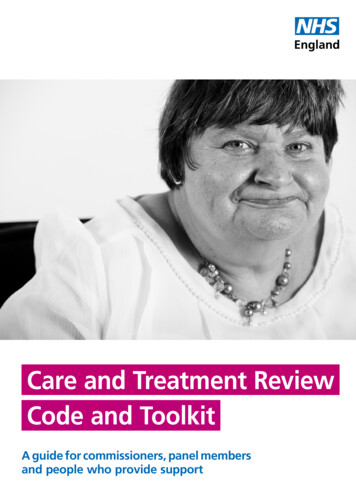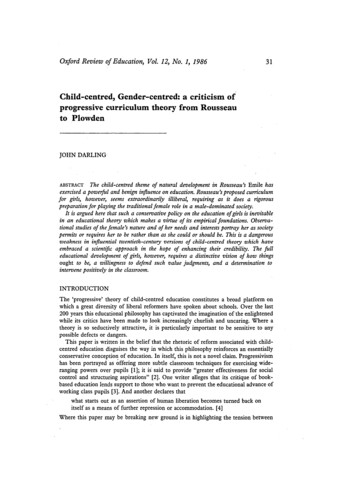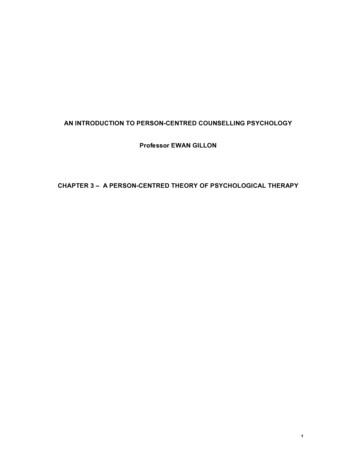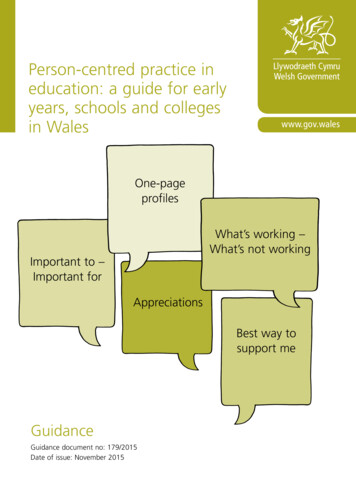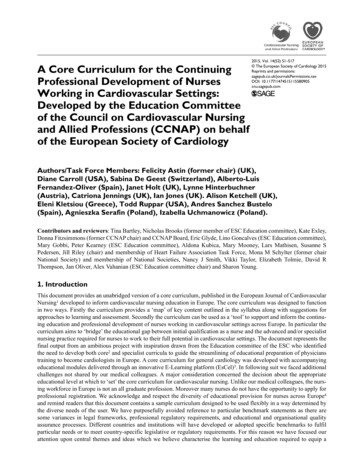
Transcription
Marulappa et al.BMC Health Services Research(2022) en AccessRESEARCHHow to implement person‑centred careand support for dementia in outpatientand home/community settings: Scoping reviewNidhi Marulappa1, Natalie N. Anderson1, Jennifer Bethell2, Anne Bourbonnais3, Fiona Kelly4,Josephine McMurray5, Heather L. Rogers6, Isabelle Vedel7 and Anna R. Gagliardi1*AbstractBackground: Little prior research focused on person-centred care and support (PCCS) for dementia in home, community or outpatient care. We aimed to describe what constitutes PCCS, how to implement it, and considerations forwomen who comprise the majority of affected persons (with dementia, carers).Methods: We conducted a scoping review by searching multiple databases from 2000 inclusive to June 7, 2020. Weextracted data on study characteristics and PCCS approaches, evaluation, determinants or the impact of strategies toimplement PCCS. We used summary statistics to report data and interpreted findings with an existing person-centredcare framework.Results: We included 22 studies with qualitative (55%) or quantitative/multiple methods design (45%) involvingaffected persons (50%), or healthcare workers (50%). Studies varied in how PCCS was conceptualized; 59% cited a PCCdefinition or framework. Affected persons and healthcare workers largely agreed on what constitutes PCCS (e.g. fosterpartnership, promote autonomy, support carers). In 4 studies that evaluated care, barriers of PCCS were reportedat the affected person (e.g. family conflict), healthcare worker (e.g. lack of knowledge) and organizational (e.g.resource constraints) levels. Studies that evaluated strategies to implement PCCS approaches were largely targetedto healthcare workers, and showed that in-person inter-professional educational meetings yielded both perceived(e.g. improved engagement of affected persons) and observed (e.g. use of PCCS approaches) beneficial outcomes.Few studies reported results by gender or other intersectional factors, and none revealed if or how to tailor PCCS forwomen. This synthesis confirmed and elaborated the PCC framework, resulting in a Framework of PCCS for Dementia.Conclusion: Despite the paucity of research on PCCS for dementia, synthesis of knowledge from diverse studiesinto a Framework provides interim guidance for those planning or evaluating dementia services in outpatient, homeor community settings. Further research is needed to elaborate the Framework, evaluate PCCS for dementia, exploredeterminants, and develop strategies to implement and scale-up PCCS approaches. Such studies should explorehow to tailor PCCS needs and preferences based on input from persons with dementia, and by sex/gender and otherintersectional factors such as ethnicity or culture.Keywords: Neurocognitive disorder, Dementia, Person-centred care, Outpatient care, Home care, Implementation,Scoping review*Correspondence: anna.gagliardi@uhnresearch.ca1Toronto General Hospital Research Institute, University Health Network,200 Elizabeth Street, 13EN‑228, Toronto, ON M5G2C4, CanadaFull list of author information is available at the end of the article The Author(s) 2022. Open Access This article is licensed under a Creative Commons Attribution 4.0 International License, whichpermits use, sharing, adaptation, distribution and reproduction in any medium or format, as long as you give appropriate credit to theoriginal author(s) and the source, provide a link to the Creative Commons licence, and indicate if changes were made. The images orother third party material in this article are included in the article’s Creative Commons licence, unless indicated otherwise in a credit lineto the material. If material is not included in the article’s Creative Commons licence and your intended use is not permitted by statutoryregulation or exceeds the permitted use, you will need to obtain permission directly from the copyright holder. To view a copy of thislicence, visit http:// creat iveco mmons. org/ licen ses/ by/4. 0/. The Creative Commons Public Domain Dedication waiver (http:// creat iveco mmons. org/ publi cdoma in/ zero/1. 0/) applies to the data made available in this article, unless otherwise stated in a credit line to the data.
Marulappa et al. BMC Health Services Research(2022) 22:541BackgroundDementia is expected to affect 152 million people by2050, and is the second largest cause of disability forolder persons and the seventh leading cause of death [1].Dementia refers to mild, moderate or advanced cognitive impairment that affects memory, cognitive function, behaviour and ability to perform activities of dailyliving [2]. Alzheimer’s disease accounts for 60–80% ofcases [2]. People with dementia have complex psychological, social and biomedical needs, which largely fall oncaregivers (i.e. family/carers), negatively impacting caregiver employment, health and well-being [1, 2]. The costimposed by dementia is approximately USD 818 billion per year globally, a considerable burden for healthcare systems and society at large [1]. To improve careand support for those affected by dementia, the WorldHealth Assembly created a global dementia action plan in2017 calling for research and innovation on risk reduction, diagnosis, treatment, and support for people withdementia [3], prompting the development of dementiastrategies in many countries.Person-centred care involves partnership with patientsand family carers to tailor care to clinical needs, life circumstances and personal preferences; and offer knowledge, skills and access to supports that optimize qualityof life [4, 5]. While person- rather than disease-centreddementia care is recognized as a worldwide priority [3, 6,7], a scoping review (88 studies, 1998–2015) revealed little insight on how to implement it [8]. Instead, dementiaresearch arbitrarily labelled “person-centred” has largelyfocused on diagnosis or clinical management, particularly in institutional settings [9]. Given that the majorityof persons with dementia live at home, high quality outpatient care and support can reduce hospitalization oremergent care, and prevent or delay institutionalization[10, 11]. Research on outpatient primary care showedthat patient-centredness of consultations decreased withincreasing visit complexity [12], and specific to dementia, several person-centred care constraints (e.g. lackof time, low reimbursement, lack of interdisciplinaryteams or links with community agencies) and unfavourable attitudes to person-centred care (e.g. belief that careand support should be provided elsewhere by community and social services) delayed detection of problems,and increased reliance on pharmacological rather thanpsychosocial management approaches [13, 14]. Similarly,research found that home or community support services(e.g. physical therapy, meal preparation) did not meetpatient or caregiver needs because they were standardized rather than person-centred [10, 15–17].Person-centred care is proven to enhance patientimportant and clinical outcomes [18, 19] and widelyadvocated for those affected by dementia [3, 6, 7], yetPage 2 of 15person-centred dementia care and support appear tobe lacking [12–14]. In particular, dementia disproportionately affects women. Two-thirds of persons withdementia are women, an escalating reality as olderpersons are increasingly women, the symptoms theylive with are more severe, most caregivers of the nearly70% of home-dwelling persons with dementia are wivesor daughters, and more women than men are likely tobe institutionalized [1, 20, 21]. This has led to calls forgreater insight on gender issues of living with or caring for someone with dementia [20]. Such insight couldbe used to tailor care and support for women, who arenot a homogeneous group, according to intersectionalfactors including but not limited to age, ethno-culturalbackground and socioeconomic status. The purposeof our research was to synthesize published researchand generate insight on how to achieve person-centreddementia care and support (PCCS). The objectiveswere to identify: (1) what constitutes PCCS, (2) how toimplement PCCS in outpatient or home /communitybased care including policies, programs, interventionsor tools aimed at patients, carers or clinicians, (3) howto tailor PCCS for women given that two-thirds of persons with dementia are women as are most carers ofpersons with dementia [1, 20, 21], and to (4) generate aframework of PCCS for dementia.MethodsApproachWe conducted a scoping review comprised of five steps:scoping, searching, screening, data extraction, and dataanalysis, and complied with standard methods anda reporting checklist specific to scoping reviews [22,23]. Similar in rigour to a systematic review, we chosea scoping review because it accommodates a rangeof study designs and outcomes, establishes baselineknowledge on a given topic, and reveals gaps in knowledge that warrant ongoing primary research [24]. Thereview question was how to implement PCCS. Theresearch team, included clinicians (primary care, nursing) and health services researchers with expertise inthe topics of dementia, person-centred care, patientengagement and women’s health, and the methods ofqualitative and quantitative research, and syntheses;who contributed to multiple components: conceptualization, study design, eligibility criteria, review andinterpretation of data, and report preparation. Wedid not register a protocol as scoping reviews are notaccepted by PROSPERO. The University Health Network Research Ethics Board did not require approval asdata were publicly available, and we did not register aprotocol.
Marulappa et al. BMC Health Services Research(2022) 22:541ScopingTo familiarize ourselves with potentially relevant literature, we conducted an exploratory search in MEDLINEusing medical subject headings (MeSH): dementia orAlzheimer’s disease AND patient-centered care. Afterreviewing search results and identifying examples of relevant studies, we generated eligibility criteria based on aPICO (participants, issue, context, outcomes) frameworkand planned a targeted, comprehensive search strategy.EligibilityDetailed eligibility criteria are described in AdditionalFile 1. In brief, participants were community-dwellingpersons with diagnosed dementia or caring for a personwith dementia, or healthcare workers providing outpatient, home- or community-based (i.e. day centres) careor support to such persons. The issue of interest wasperson-centred care, defined for this study based on asix-domain framework by McCormack et al. as a multidimensional approach to care that fosters a healing relationship, exchanges information, addresses emotions orconcerns, manages uncertainty, shares decision-making,and enables self-management [25]. Though not specific to dementia, we chose this framework because itwas robustly developed with input from patients, carers and clinicians, and with 28 items in six domains,offers a thorough description of person-centred care[25]. Throughout this manuscript we refer to personcentred care, which acknowledges the longstanding concepts of personhood and holistic care in the dementiacontext [8, 9]. However, given the interchangeable useof terms for person-centred care, we used an inclusiveapproach where person-centred care could be referredto as patient- or person-centred care, family-centred careor a synonymous term. In prior research we elaboratedon approaches within those domains [26, 27]. For example, approaches to foster a healing relationship includedestablish rapport (engage in brief, friendly conversationprior to clinical discussion) and assume a non-judgmental attitude (speak in a respectful manner). In addition toperson-centred care approaches such as these, we werealso interested in strategies aimed at patients/carers orhealthcare workers to implement (i.e. promote/support)use of person-centred care approaches including policies, programs, interventions or tools. Context referredto studies exploring or describing what patients, carers or healthcare workers view as person-centred careapproaches; determinants influencing the use or impactof person-centred care approaches (enablers, barriers),or the impact of strategies (policies, programs, interventions, tools) to promote or support PCC approachestargeted to patients, carers or healthcare workers. StudyPage 3 of 15design referred to empirical research with explicit methods of data collection and analysis including qualitative(e.g. interviews, focus groups), quantitative (e.g. questionnaires, retrospective or prospective cohort studies,trials) or multiple/ mixed methods research published inEnglish language. Outcomes or impacts included but werenot limited to awareness, knowledge, practice or impactof person-centred care approaches, or determinants ofuse or impact. To focus on home- or community-basedPCCS, we excluded studies if participants were trainees,the context was long term or palliative care, person-centred care referred to clinical care/management. We alsoexcluded protocols, abstracts, editorials, letters, commentaries, clinical case studies, or clinical guidelines.Reviews were not eligible but we screened references foreligible studies.SearchingARG, who has medical librarian training, developed asearch strategy that complied with the Peer Review ofElectronic Search Strategy reporting criteria (AdditionalFile 2) [28]. In our prior experience, a search employing the MeSH term “patient-centered care” generates avery large number of results including a diffuse range ofun-related topics [29]. To better target studies of PCCapproaches, our search strategy combined the MeSHterm “patient-centered care” with keywords for synonymous terms. NNA searched MEDLINE, EMBASE,CINAHL, SCOPUS, the Cochrane Library, and JoannaBriggs Institute Database of Systematic Reviews fromJanuary 1, 2000 to June 7, 2020. We chose 2000 as thestart date to coincide with the emergence of widespreadadvocacy for person-centred care [30]. We exportedsearch results to Excel for screening.ScreeningTo pilot test screening, NM, NNA and ARG independently screened titles and abstracts for the first 50 searchresults, then compared and discussed discrepancies,and how to interpret and apply screening criteria. NMscreened remaining titles/abstracts in duplicate withNNA, and they resolved uncertainty or discrepancy withARG through discussion. NM retrieved and screenedfull-text articles concurrent with data extraction, andNNA or ARG prospectively resolved uncertainties asthey arose.Data extraction and analysisWe extracted data on study characteristics (author, publication year, country, objective, research design, personcentred care model or theory, women sub-analyses) andperson-centred care approaches, evaluations to assessperson-centred care, determinants (enablers/barriers), or
Marulappa et al. BMC Health Services Research(2022) 22:541the impact of strategies to promote or support personcentred care. We described strategies using the Workgroup for Intervention Development and EvaluationResearch reporting framework: content, format, delivery,timing and personnel [31]. As a pilot test, NM, NNA andARG independently extracted data from three articles,then compared and discussed results to clarify what toextract and how. NM subsequently extracted all data withassistance from NNA, and ARG independently reviewedall data. We tabulated aspects of person-centred careextracted from included studies based on McCormack’sperson-centred care framework [25We used summarystatistics to describe study characteristics, the numberof studies by type of participant or demographics (e.g.women), and the number and type of person-centredcare domains addressed in studies. We used text to compile unique enablers and barriers, described the characteristics and impact of strategies to promote or supportperson-centred care approaches, and noted considerations specific to women with dementia or women carersof persons with dementia. We transformed all findings,including person-centred care concepts, enablers, barriers and recommendations into PCCS strategies, mappedthem to McCormack’s person-centred care framework[25], and noted additional unique person-centred careelements identified in included studies.ResultsStudies includedA total of 1394 unique records were identified bysearches and screening of review references, and 1347were excluded by screening titles/abstracts. Among 47Fig. 1 PRISMA diagramPage 4 of 15full-text articles screened, 25 were excluded due to setting (11), publication type or date (7), topic was clinical care (4), participants were trainees (2) or the studyonly concluded that PCC was needed (1). A total of 22studies were included for review (Fig. 1). Data extractedfrom included studies are available in Additional File 3[32–52].Study characteristicsStudies were largely conducted in the United Kingdom(9,40.9%), United States (7, 31.8%) followed by Sweden(3, 13.6%) and one (4.5%) each in Canada, China and theNetherlands. Twelve (54.5%) studies employed qualitative methods including interviews (5), focus groups (5)or both (2). Eight (36.4%) studies employed quantitative methods including cohort study (5), randomizedcontrolled trial (2), and survey (1). Two (9.1%) studies employed multiple methods: one a survey and focusgroups, the other a randomized controlled trial andfocus groups. With respect to setting, 11 (50.0%) studiesaddressed outpatient care (including primary care), and11 (50.0%) addressed home or community day care. Ten(45.5%) studies addressed support, 7 (31.8%) addressedcare, and 5 (22.7%) overall management including bothcare and support. Regarding participants, 1 (4.5%)included only persons with dementia, 7 (31.8%) bothpersons with dementia and carers, 3 (13.6%) carers only,9 (40.9%) healthcare workers only and 2 (9.1%) on bothcarers and healthcare workers. Ten (45.5%) studies specified dementia stage: 5 mild cognitive impairment, 2 milddementia, 2 both mild and moderate dementia, and 1moderate dementia.
Marulappa et al. BMC Health Services Research(2022) 22:541PCC conceptsWhile all studies mentioned person-centred care concepts in their background or rationale, 13 (59.1%) studiesexplicitly referred to a person-centred care definition orframework, and most often this was Kitwood’s philosophy of personhood (6, 46.2%). When describing personcentred care, studies most often referred to a holisticapproach involving partnership between healthcareworkers and persons with dementia and carers, ensuring dignity and respect, recognizing the person’s lifeand current abilities, tailoring care to individual needsand preferences, optimizing independence by providing information and sharing decisions rather than taking over, and engaging in meaningful activity. Table 1summarizes person-centred care concepts measured orgenerated by studies mapped to the McCormack personcentred care framework [26]. One study did not addressany person-centred care domains because it focused onorganizational enablers and barriers to implementingPCC [48]. The remaining 21 studies featured a median of4 of 6 possible person-centred care domains (range 4 to6). Most often, studies included the domains of addressPage 5 of 15emotions (21, 100.0%) and exchange information (19,90.5%). Least often, studies included the domains ofenable self-care (9, 42.9%) and manage uncertainty (7,33.3%).Identification of person‑centred care approachesSeven (31.8%) studies explored what constitutes personcentred care in community, home or outpatient settings. One study involving persons with dementia andcarers generated a framework of 41 person-centred careapproaches in five domains: medical care, physical quality of life, social and emotional quality of life, access toservices and supports, and caregiver support [36]. Thatsame study [36], plus two studies involving carers [37,47], two studies involving healthcare workers [40, 44],and one study involving both [52] yielded commonthemes. Person-centred care approaches across thesestudies included: pay attention to verbal and behaviouralcues to understand the affected person’s needs, promoteautonomy and independence by engaging them in meaningful activity (e.g. family functions, planning and preparing meals), respect their abilities in a non-judgementalTable 1 Person-centred care domains in included studiesStudyPerson-centred care domains (n,% of 21 studies)Total domains (n)Foster theExchangeAddress emotions ManageShare decisions Enable self-carerelationship informationuncertaintyBerglund 2019 [53]Hancox 2019 [32]Ihara 2019 [33]Hung 2018 [34]Hall 2018 [35]Jennings 2018 [36]Chung 2017 [37]Guan 2017 [38] Wang 2017 [39]Gaugler 2015 [42]Edwards 2015 [43]Smythe 2015 [44]Edwards 2014 [45]Lerner 2014 [46]McClendon 2013 [47]Kirkley 2011 [48]Robinson 2010 [49] Ericson 2001 [52]Total Vernooji-Dassen 2010 [50] Zaleta 2010 [51] Johansson 2017 [40]Han 2016 [41] 14 (66.7) 19 (90.5) 5 4542 4453 15 (71.4)453 7 (33.3)34 655 21 (100.0) 0 9 (42.9)5435median 4range 4–6
Marulappa et al. BMC Health Services Research(2022) 22:541manner by practising kindness and patience, and create stability through routines and continuity. Healthcareworkers emphasized working in partnership with persons with dementia and carers to enable decision-makingrather than taking over, and the need to support carers,who said that constantly setting goals, gauging situations,making adjustments and negotiating through trial-anderror was stressful.Carers and healthcare workers differed on one aspect.Carers were motivated to keep their affected familymember at home because they were attuned to needsand preferences through intimate knowledge of the person, and were therefore best able to optimize care andsupport. Carers thought these essential qualities couldnot be acquired by healthcare workers through training.While healthcare workers agreed that home was the idealenvironment, they believed it was not always possible.Healthcare workers believed that they could be equippedto provide person-centred care through training, and viacontinuity of one or a few healthcare workers who woulddevelop insight to a person’s needs by getting to knowthem.One additional study involving persons with dementia,carers and healthcare workers revealed four elements ofperson-centred diagnosis of dementia in primary care:reframing dementia as cognitive decline, thus allowingtime for the affected person and carer to adjust to thediagnosis; paying attention to cues other than memoryloss (e.g. behaviours, challenges) for recognizing dementia; engaging the entire primary care team (i.e. administrative or clerical staff ) in identifying signs of dementia;being aware of available care and support services in thecommunity and secondary care [45].Page 6 of 15Evaluation of PCC experienceFour (18.2%) studies assessed care and found it was notperson-centred. One study interviewed persons withdementia and carers about physiotherapy [35]. Participants said that physiotherapists did not: look beyonddementia to get to know the affected person, tailorexercises or discuss how to adapt the exercise to overcome dementia-related difficulties (e.g. short routine),or clearly communicate the plan of treatment such thatthey felt confused and abandoned when it ceased. Threestudies employed observation of recorded consultationsbetween persons with dementia, carers and physicians orgenetic counselors when dementia risk or diagnosis wasdisclosed [38, 46, 51]. Genetic counselors and physicianscontributed the majority of utterances, which largelyfocused on biomedical information, providing lifestyleinformation and checking for understanding, and lessoften on expressing empathy or reassurance. Comparedwith such sessions, in those categorized as person-centred, healthcare workers gave less biomedical information, asked more psychosocial questions, and made moreeffort to build partnerships, and affected persons andcarers contributed a greater proportion of utterances.PCC enablers and barriersTable 2 summarizes enablers and barriers of person-centred dementia care and support reported in four (18.2%)studies [32, 44, 48, 50]. At the patient/carer level, enablers included practical strategies (memory aids, dailyroutine) and perceived value (tangible benefits, positivepast experience), while barriers included lack of practical or emotional support from carer, reluctance to behelped, family conflict, and geographic or social distanceTable 2 Determinants of person-centred dementia care and supportLevelEnablersBarriersPatient or Carer Developing daily routine Perceived or tangible benefits Memory aids Positive past experience Lack of practical or emotional supportfrom their carer to routinize activity Reluctance to be helped Family conflict Children geographically or socially distantfrom affected parent Children feeling like unwanted intruderHealthcare worker Mutual support from colleague Job satisfaction Experiential learning Awareness of family dynamic problems Maintaining neutral disposition Following family lead Creating a safe environment in which to offer help Variable knowledge/understanding of PCC Attitudes about dementia Perceived lack of control/time Perceived low status within organizationOrganization Leadership style that promotes PCCS How managers support and value staff Risk management Opinion leaders who advocate and model PCCS PCC integrated in policy documents Inadequate staffing Resource constraints Pressurized environment
Marulappa et al. BMC Health Services Research(2022) 22:541between children and affected parents. At the healthcare worker level, individual enablers included mutualsupport from colleagues, job satisfaction and experiential learning through exposure to persons affected bydementia; and service enablers included awareness offamily problems, following the family’s lead, maintaining a neutral disposition and creating a safe environmentin which to offer support. Healthcare worker barriersincluded variable knowledge and understanding aboutperson-centred care, negative attitudes about dementia,and perceived lack of control or time, and perceived lowstatus within the organization. Organizational enablersincluded positive leadership style and support for staff,risk management, opinion leaders who championed andmodeled person-centred care, and policy documents thatpromoted person-centred care. Organizational barriersincluded resource constraints, inadequate staffing and astressful environment.Strategies to implement PCC approachesTable 3 summarizes the characteristics of strategies topromote or support the implementation of person-centred care approaches reported in 8 (36.4%) studies. Fivestudies targeted at healthcare workers used in-personeducational meetings involving both didactic and interactive components [34, 39, 43, 49, 53]. Meetings rangedfrom single one-hour sessions to a three-day meeting,and all but one that involved psychiatrists [50] were interdisciplinary. All studies reported positive impacts. Basedon qualitative studies, perceived impacts included beneficial patient health and outcomes (e.g. improved healthand nutritional status, health problems detected earlier,referral for screening or to memory clinics, tailored support, reduced use of primary and hospital care, delayedinstitutionalization, patients and carers more engagedin decision-making) and benefits for healthcare workers (deeper insight and understanding of patient behaviour and needs, more compassion for patients as personsrather than symptoms to be managed, appreciation forthe complexity of dementia care, enhanced team collaboration, greater job satisfaction). By instrument or surveydata, educational meetings improved knowledge about,attitude to and use of person-centred care approaches todementia (e.g. structure of consultations, communicationtechniques); and awareness of behavioural and functionalsymptoms, availability of support services and what constitutes person-centred care. Healthcare workers saidthat education was useful, would have a positive impacton their ability to provide dementia care, and in particular they valued communication techniques.Three studies targeted at persons with dementia orcarers also reported positive impacts. One study evaluated an educational strategy targeted at carers. Based onPage 7 of 15a survey of carers, three one-hour online modules (text,videos) featuring vignettes and interviews with affectedpersons and carers increased knowledge and confidencein caregiving skills, and they appreciated the flexibilityof online delivery of the educational program [42]. Twostudies evaluated personalized strategies to implementmeaningful activities. Based on third-party observation of persons with dementia, benefits of a single onehour personalized music program improved patientmood (smiling, joy, alertness, relaxed, calm) and socialengagement (eye contact, eye movement, talking), anddecreased sleeping both during and directly after the session [33]. Interviews with carers revealed the benefitsof a monthly four-hour social visit program (e.g. dinner,museum visit) from first-year medical students who wereexposed to didactic and interactive educational meetings on dementia. Carers were pleased that their spouseenjoyed the program, it provided them with respite, andthey also enjoyed participating in social activity. Carerssaid that persons with dementia benefited from an outletto socialize with someone other than family, which provided them with social and intellectual stimuli [41].Person‑centred care for women affected by dementiaFew (4, 18.2%) studies reported sub-analyses by sex/gender or other intersectional factors. In a survey of 148carers (62% women) to identify what constitutes personcentred carer approaches, women carers were more likelyto provide person-centred care at home comp
scoping, searching, screening, data extraction, and data analysis, and complied with standard methods and a reporting checklist specic to scoping reviews [22, 23]. Similar in rigour to a systematic review, we chose a scoping review because it accommodates a range of study designs and outcomes, establishes baseline

